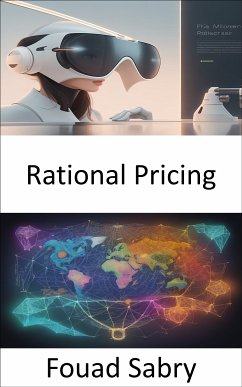What is Rational Pricing
The assumption that asset prices, and consequently asset pricing models, will represent the arbitrage-free price of the asset is known as rational pricing. This assumption is based on the fact that any departure from this price will be "arbitraged away" throughout the process of rational pricing. In addition to being an essential component in the pricing of derivative instruments, this assumption is helpful in determining the value of fixed income securities, notably bonds.
How you will benefit
(I) Insights, and validations about the following topics:
Chapter 1: Rational pricing
Chapter 2: Arbitrage
Chapter 3: Derivative (finance)
Chapter 4: Financial economics
Chapter 5: Black-Scholes model
Chapter 6: Real options valuation
Chapter 7: Forward contract
Chapter 8: Binomial options pricing model
Chapter 9: Convertible bond
Chapter 10: Valuation (finance)
Chapter 11: Risk-neutral measure
Chapter 12: Swap (finance)
Chapter 13: Bond valuation
Chapter 14: Arbitrage pricing theory
Chapter 15: Fixed income arbitrage
Chapter 16: Business valuation
Chapter 17: Asset pricing
Chapter 18: Lattice model (finance)
Chapter 19: Real business-cycle theory
Chapter 20: Bootstrapping (finance)
Chapter 21: Replicating portfolio
(II) Answering the public top questions about rational pricing.
(III) Real world examples for the usage of rational pricing in many fields.
Who this book is for
Professionals, undergraduate and graduate students, enthusiasts, hobbyists, and those who want to go beyond basic knowledge or information for any kind of Rational Pricing.
The assumption that asset prices, and consequently asset pricing models, will represent the arbitrage-free price of the asset is known as rational pricing. This assumption is based on the fact that any departure from this price will be "arbitraged away" throughout the process of rational pricing. In addition to being an essential component in the pricing of derivative instruments, this assumption is helpful in determining the value of fixed income securities, notably bonds.
How you will benefit
(I) Insights, and validations about the following topics:
Chapter 1: Rational pricing
Chapter 2: Arbitrage
Chapter 3: Derivative (finance)
Chapter 4: Financial economics
Chapter 5: Black-Scholes model
Chapter 6: Real options valuation
Chapter 7: Forward contract
Chapter 8: Binomial options pricing model
Chapter 9: Convertible bond
Chapter 10: Valuation (finance)
Chapter 11: Risk-neutral measure
Chapter 12: Swap (finance)
Chapter 13: Bond valuation
Chapter 14: Arbitrage pricing theory
Chapter 15: Fixed income arbitrage
Chapter 16: Business valuation
Chapter 17: Asset pricing
Chapter 18: Lattice model (finance)
Chapter 19: Real business-cycle theory
Chapter 20: Bootstrapping (finance)
Chapter 21: Replicating portfolio
(II) Answering the public top questions about rational pricing.
(III) Real world examples for the usage of rational pricing in many fields.
Who this book is for
Professionals, undergraduate and graduate students, enthusiasts, hobbyists, and those who want to go beyond basic knowledge or information for any kind of Rational Pricing.
Dieser Download kann aus rechtlichen Gründen nur mit Rechnungsadresse in A, B, BG, CY, CZ, D, DK, EW, E, FIN, F, GR, H, IRL, I, LT, L, LR, M, NL, PL, P, R, S, SLO, SK ausgeliefert werden.









